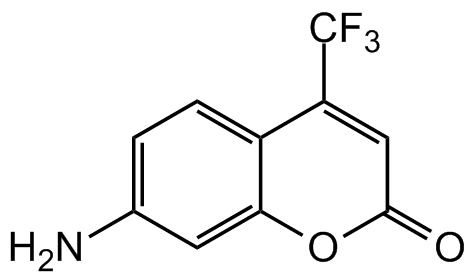
Chemical Structure
7-Amino-4-trifluoromethylcoumarin
CDX-A0029
CAS Number53518-15-3
Product group Chemicals
Estimated Purity>99%
Overview
- SupplierChemodex
- Product Name7-Amino-4-trifluoromethylcoumarin [53518-15-3]
- Delivery Days Customer10
- CAS Number53518-15-3
- CertificationResearch Use Only
- Estimated Purity>99%
- Scientific Description7-Amino-4-trifluoromethylcoumarin (AFC) is used in the synthesis of substrates for the fluorometric assay of proteolytic enzymes in biological fluids and therefore the precursor for a variety of AFC enzyme substrates. It is a fluorogenic standard useful as a calibration standard for AFC-based enzyme substrates and for quantitating assays monitoring 7-amino-4-trifluoromethylcoumarin (AFC) release such as those utilizing ubiquitin-AFC. Compared to AMC enzyme substrates, fluorogenic AFC substrates generate AFC that has longer absorption and fluorescence wavelength that AMC. AFC is also suitable as laser dye. Spectral Data: lambdaex 376nm, lambdaem 482nm, Quantum yield 0.531. - Chemical. CAS: 53518-15-3. Formula: C10H6F3NO2. MW: 229.16. 7-Amino-4-trifluoromethylcoumarin (AFC) is used in the synthesis of substrates for the fluorometric assay of proteolytic enzymes in biological fluids and therefore the precursor for a variety of AFC enzyme substrates. It is a fluorogenic standard useful as a calibration standard for AFC-based enzyme substrates and for quantitating assays monitoring 7-amino-4-trifluoromethylcoumarin (AFC) release such as those utilizing ubiquitin-AFC. Compared to AMC enzyme substrates, fluorogenic AFC substrates generate AFC that has longer absorption and fluorescence wavelength that AMC. AFC is also suitable as laser dye. Spectral Data: lambdaex 376nm, lambdaem 482nm, Quantum yield 0.531.
- Storage InstructionRT
- UNSPSC41116134

![7-Amino-4-(trifluoromethyl)coumarin [53518-15-3]](https://www.targetmol.com/group3/M00/37/0E/CgoaEGayR1iEOrnGAAAAAFUzgxs982.png)